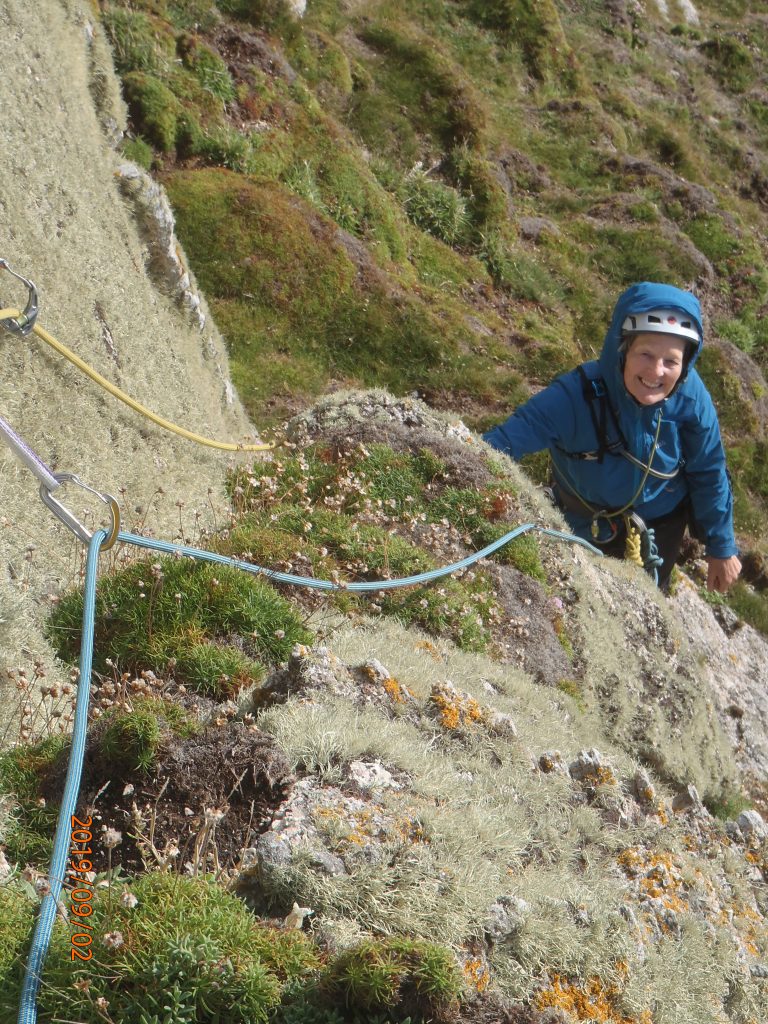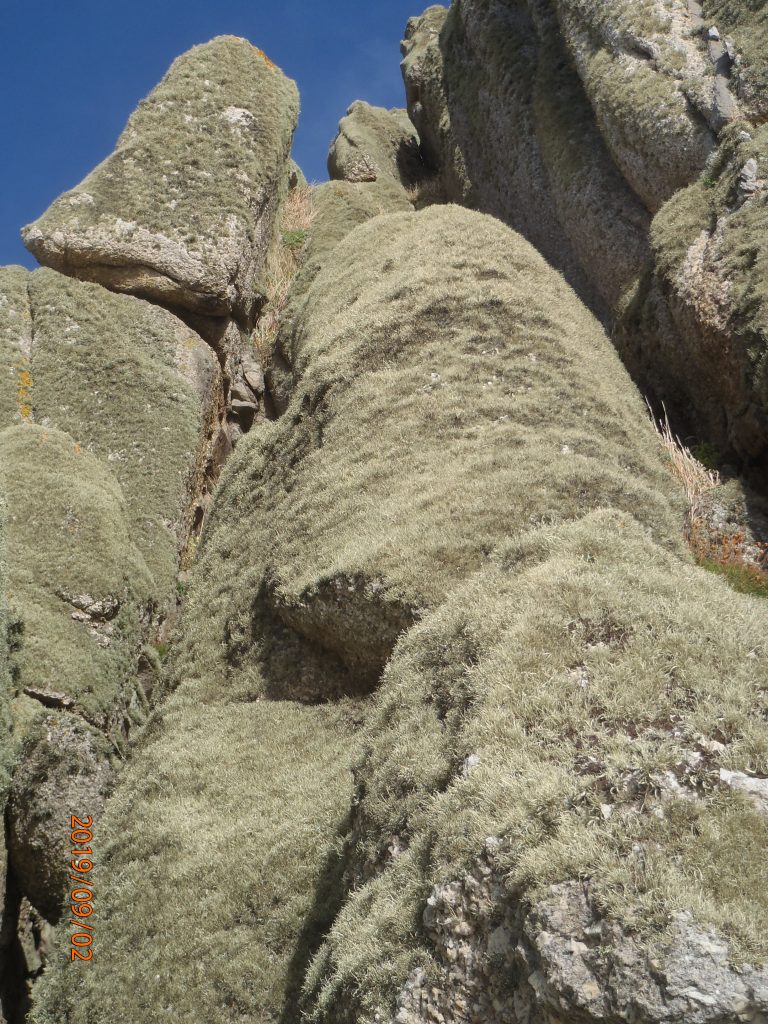Last year’s trip to Lundy saw us based at Tibbetts, which is the ideal location from which to explore the northern section of the island. 100m beyond Arch Zawn, and recognisable by the curiously shaped block perched just below its top, the Long Roost Ridge forms the basis for a 60m V Diff, first climbed in 1969 by those redoubtable south-west pioneers, Rear-Admiral Keith Lawder, his grandson Iain Peters, and Mike Banks MBE. The ability to follow in those illustrious footsteps was an obvious attraction, but I was curious as to why a route with such a pedigree should be devoid of UKC ticks (in fact, it wasn’t even listed on the database – most odd). Only one way to find out……..
Always game for a laugh, Shirley accompanied me on this venture, and having scrambled down to sea level declared that she liked the look of the first pitch and racked up accordingly. I was a little perplexed at such enthusiasm as the pitch follows a wide crack formed by a steep corner and looked like it might prove quite testing at the grade. In fact, to my eyes it had sandbag written all over it, but knowing it wise to keep my own counsel, Shirley donned her rose tinted glasses and set off with gusto. An early hex placement added confidence, but then the corner reared up and progress tailed off. A search for more gear proved fruitless, so with cries of “this is very bold” a retreat ensued. With the tide having turned and being faced with an incoming sea, I was only too happy to take over the lead. Reaching Shirley’s high point a touch of guile and cunning saw a Rock 1 firmly located in the granite, which provided protection for some very wide bridging that was rewarded by a placement for an HB Offset 10 – ah, bliss! The crux now ensued with a shin scraping throw of the leg onto a slopey ledge and a semi-mantle to get upright. All very challenging and, to my mind, more like HS 4b than V Diff. A series of strenuous layback manoeuvres completed the pitch. Clearly the Admiral and friends were made of stern stuff. Shirley’s comments on the route grading are unfit for publication, so it’s time to review the second pitch.
References to scrambling upwards were a little misleading as vertical rock endowed with flaring cracks made for difficult progress, and required further dipping into the guile and cunning box to fashion any sort of protection. The guide mentions an optional stance at a grassy col, but with Shirley out of sight and the wind blowing, I elected to belay early. Shirley then led over the grassy col to a couple of small spikes that I assured her would form an adequate belay. Alas, these did not meet Plas-y-Brenin standards, but having joined her, I reasoned that with nothing else on offer, we might have to relax our standards a little. The guide advises further progress up a leftward slanting crack, to which Shirley’s only comment was “well, I’m not going up there!” The difficulty seemed to be that the crack had become home to some rather luxuriant vegetation. In fact, it wasn’t apparent that a crack existed at all. However, reckoning that the Admiral would be appalled if we made a disorderly retreat from the grassy col, I felt compelled to lead on. A couple of moves saw me atop the dubious spikes and then a wholesale ransacking of the guile and cunning box was required to find a protection placement. Lacking shears and trowel, I resorted to pulling out vegetation by hand. Shirley advised that she thought this wasn’t allowed on Lundy, but on grounds of preservation of life, the excavation of a sound Dragon 4 placement felt like a necessity. Buoyed up by this I moved jauntily up the flora until an undercut flake offered a couple of more easily accessed gear placements.
The final pitch is described as easy climbing up a broken chimney, but there was a catch; the chimney appeared to have been covered in a carpet of deep, green sea grass. The jaundiced look in Shirley’s eye told me it would be unwise to offer her the lead at this stage, so off I went again. I’ve climbed a number of pitches on Lundy where the sea grass makes things look unappealing from below, but the passage of other climbers has kept the holds clean. Sadly this wasn’t the case on Long Roost Ridge. In fact, I was beginning to wonder if there had been any ascents in the fifty years since the Admiral and friends first climbed it. Lacking a stiff hand brush, the required technique seemed to be to rub vigorously with the palm of the hand to remove a patch of sea grass in the approximate position in which the feet might be positioned. Consequently progress was slow, but the revealed granite was super grippy (no polish here) and further wide bridging manoeuvres allowed progress to be made towards the top. With muscles and joints beginning to ache I was rather glad to make it to the final belay, and before long a rather hungry looking Shirley arrived to join me. Pausing only long enough to shoot me another withering glance, she pulled the ropes through to the sacks and set about devouring some well earned rations.
Little travelled it may be but Long Roost Ridge is now firmly on the UKC database, sporting two ticks. I’ve voted it HS for the difficulty of the first pitch and awarded it one star on account of its compelling nature. For those in search of an adventurous experience, well away from the crowds, I strongly recommend it – just remember to pack a variety of gardening tools and a stiff hand brush!
John Brayshaw



















